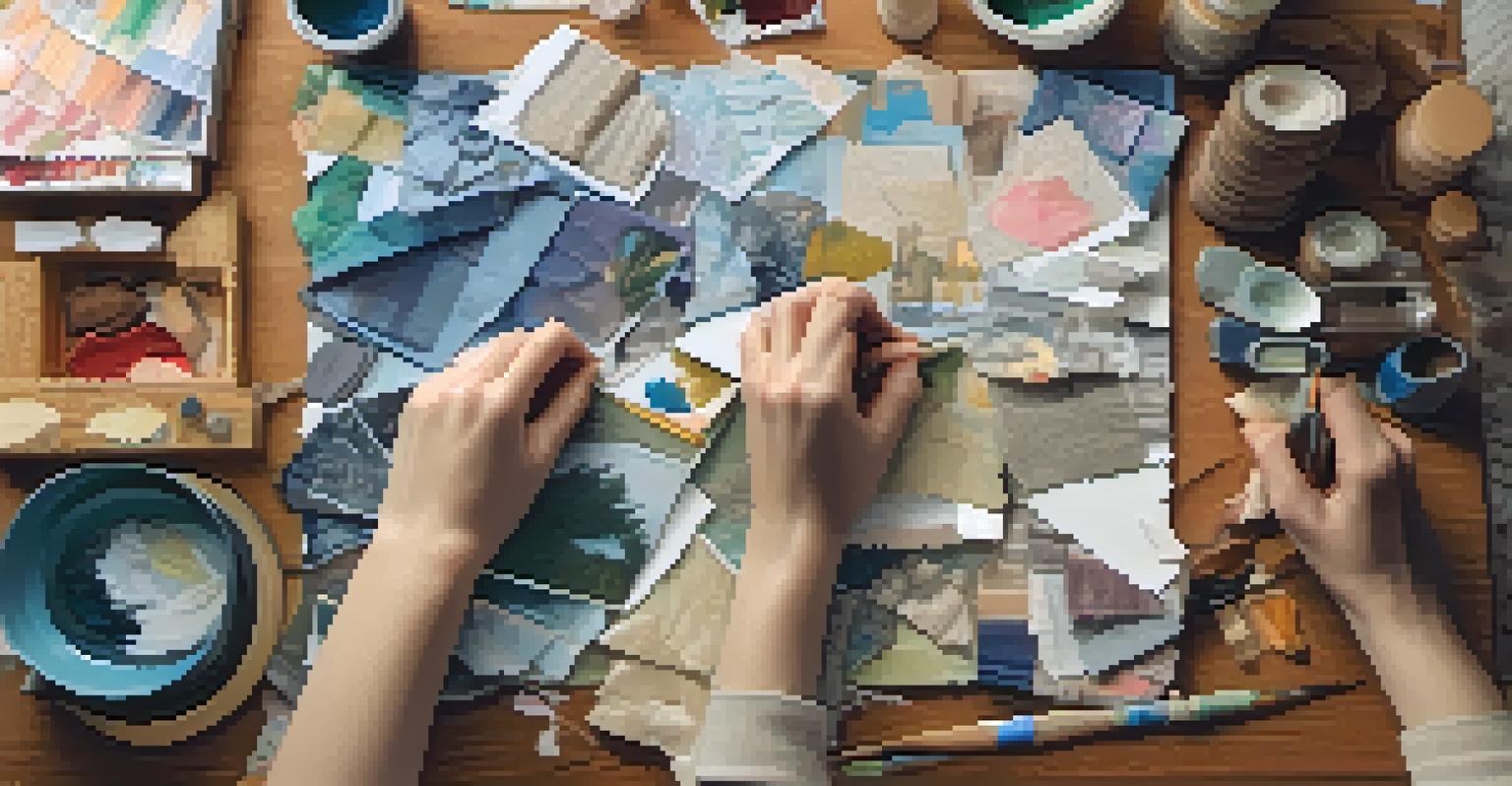Art Therapy: Creative Expression in Addiction Recovery

Understanding Art Therapy and Its Benefits
Art therapy combines creative expression with psychological support, allowing individuals to communicate their feelings through art. This therapeutic approach can be particularly beneficial for those in addiction recovery, as it provides a non-verbal outlet for emotions that may be difficult to articulate. By engaging in artistic activities, participants can explore their thoughts and feelings in a safe environment, promoting self-discovery and healing.
Art enables us to find ourselves and lose ourselves at the same time.
Through various mediums such as painting, drawing, and sculpture, individuals can express the complexities of their experiences with addiction. This form of therapy encourages personal reflection and can lead to significant breakthroughs in understanding one's emotions and behaviors. Such insights can be crucial in the recovery process, helping individuals identify triggers and develop healthier coping mechanisms.
Moreover, art therapy fosters a sense of accomplishment and boosts self-esteem, which can often be diminished during addiction. As individuals create and complete artwork, they experience a sense of pride and ownership over their creations. This newfound confidence can pave the way for more positive changes and reinforce the commitment to recovery.
The Role of Creative Expression in Healing
Creative expression serves as a powerful tool in healing by allowing individuals to process their experiences in a unique way. When words fail, art speaks volumes, helping individuals articulate pain, joy, and everything in between. This process can be liberating, as it offers a way to confront and navigate complex emotions that addiction often exacerbates.

Engaging in creative activities can also provide a much-needed distraction from cravings and negative thoughts. For example, immersing oneself in painting or sculpting can shift focus away from harmful urges, offering a constructive outlet. This diversion not only supports mental well-being but also encourages individuals to develop new skills and interests that can replace old habits.
Art Therapy Aids Emotional Healing
Art therapy provides a creative outlet for individuals in addiction recovery to express emotions, fostering self-discovery and healing.
Furthermore, the act of creating art can be meditative, promoting mindfulness and presence in the moment. This mindfulness can help individuals better manage stress and anxiety, reducing the likelihood of relapse. Ultimately, creative expression becomes a vital aspect of a holistic recovery journey.
Art Therapy Techniques for Addiction Recovery
There are various techniques used in art therapy that cater to the unique needs of individuals in recovery. Some common practices include guided imagery, where clients visualize their feelings and then translate them into art, and collage-making, which allows for exploration of identity and personal history. These techniques provide a structured way for individuals to delve into their experiences with addiction and recovery.
The artist is not a different kind of person, but every person is a different kind of artist.
Another effective approach is the use of art journaling, where individuals regularly create visual representations of their thoughts and emotions. This practice not only fosters creativity but also encourages consistent self-reflection. By revisiting their journals, individuals can track their progress and recognize patterns in their emotional landscapes.
Group art therapy sessions can also be particularly beneficial, as they foster a sense of community and shared experience. Participants can connect with others facing similar challenges, creating a support network that enhances their recovery journey. Sharing artwork in a group setting encourages vulnerability and can lead to profound insights and healing.
Building Emotional Intelligence Through Art
Art therapy helps individuals in addiction recovery develop emotional intelligence, which is the ability to recognize and manage one’s emotions and understand the emotions of others. This skill is crucial for maintaining healthy relationships and making informed decisions, especially during recovery. Artistic expression encourages individuals to explore their feelings, leading to greater emotional awareness.
By creating and analyzing their art, individuals can identify patterns in their emotional responses and behaviors. For example, a person may notice that certain colors or shapes represent specific feelings or memories associated with their addiction. This awareness can be a catalyst for change, enabling individuals to address underlying issues that contribute to their substance use.
Creative Expression Boosts Recovery
Engaging in artistic activities offers individuals a constructive distraction from cravings, promoting mindfulness and emotional management.
Moreover, improved emotional intelligence can enhance interpersonal skills, making it easier to navigate relationships with family, friends, and support systems. As individuals learn to express their emotions constructively, they’re better equipped to seek help and establish boundaries, both of which are essential for long-term recovery.
Overcoming Stigmas Through Artistic Expression
Stigma surrounding addiction can often hinder recovery efforts, making individuals feel isolated and misunderstood. Art therapy serves as a powerful medium to challenge these stigmas by allowing individuals to share their stories and experiences creatively. Through art, clients can convey the complexity of addiction, fostering empathy and understanding in those who view their work.
Creating art that tells a personal story can also empower individuals to reclaim their narratives. By expressing their struggles and triumphs visually, they take control of their identity beyond addiction. This empowerment is essential in shifting perceptions and breaking down societal barriers that often accompany addiction.
Additionally, sharing artwork within communities can spark conversations about addiction and recovery. These dialogues can lead to increased awareness and support for those affected, ultimately promoting a more compassionate society. In this way, art therapy not only aids individual healing but also contributes to broader societal change.
Integrating Art Therapy into Traditional Recovery Programs
Integrating art therapy into traditional addiction recovery programs can enhance the overall effectiveness of treatment. By combining evidence-based approaches with creative expression, individuals have access to a more comprehensive recovery experience. This integration allows practitioners to address both the psychological and emotional facets of addiction, leading to more holistic healing.
For example, traditional therapy sessions can be complemented by art therapy, providing clients with varied tools to express their feelings. When individuals have multiple outlets for expression, they are more likely to engage in the recovery process wholeheartedly. This dual approach can also help clients develop a more robust support network, as they often find common ground with others in art therapy settings.
Art Builds Community and Empathy
Group art therapy fosters a sense of belonging and shared experience, helping to overcome the stigma surrounding addiction.
Furthermore, integrating art therapy into treatment plans can make recovery feel less daunting. The creative aspect can reduce resistance to therapy and increase motivation among clients. As they find joy in expressing themselves artistically, individuals are more likely to commit to their recovery journey.
Success Stories: Art Therapy in Action
Numerous success stories illustrate the profound impact of art therapy in addiction recovery. For instance, individuals who once struggled to communicate their feelings have found solace in painting or drawing, leading to breakthroughs in their recovery. These personal accounts highlight how art can facilitate healing, providing a voice for those who have felt voiceless.
One participant shared that creating a mural depicting their journey through addiction helped them process their emotions and connect with others in recovery. This collaborative project not only fostered self-expression but also strengthened bonds within the recovery community. Such stories underscore the transformative power of art therapy as a healing tool.

As more individuals share their experiences with art therapy, it becomes increasingly clear that creative expression is a vital component of recovery. These success stories inspire hope and demonstrate that healing is possible through innovative approaches like art therapy. They remind us that everyone’s journey is unique, and sometimes, the path to recovery is painted in colors we never expected.